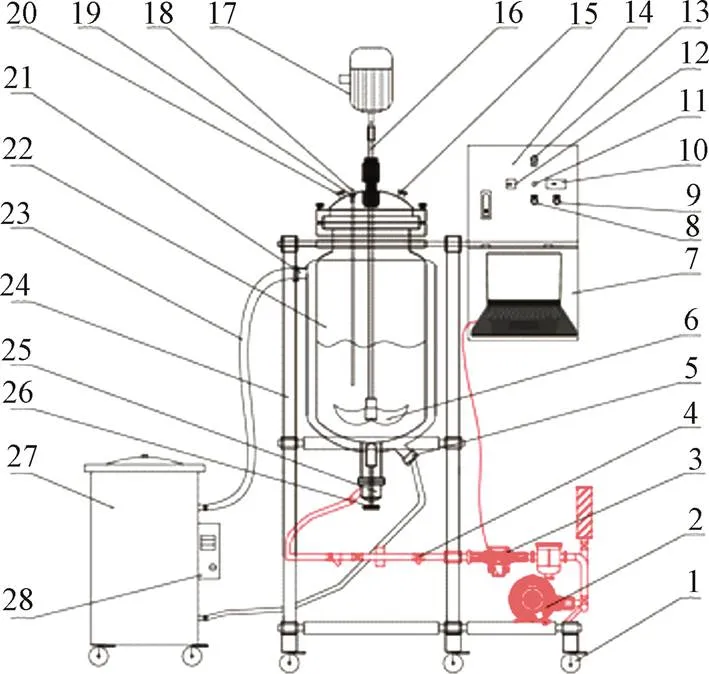在线旁路近红外实时监测粪污厌氧发酵挥发性脂肪酸含量
2020-07-10黄圆萍沈广辉韩鲁佳杨增玲
梁 浩,黄圆萍,沈广辉,韩鲁佳,杨增玲
在线旁路近红外实时监测粪污厌氧发酵挥发性脂肪酸含量
梁浩,黄圆萍,沈广辉,韩鲁佳,杨增玲※
(中国农业大学工学院,北京 100083)
厌氧发酵是畜禽粪污资源化利用的重要途径之一,挥发性脂肪酸作为重要的中间产物,可以很好地反映有机物质的降解过程,对其进行实时检测对在线监控发酵进程具有重要意义。该研究在已有实验室型厌氧发酵系统上、基于在线旁路检测方式设计了近红外实时检测装置及发酵液循环回路系统,探讨对乙酸、丙酸、异丁酸、丁酸、异戊酸、戊酸等单一挥发性脂肪酸和总挥发性脂肪酸进行在线实时检测的可行性。检测结果表明,所设计的在线检测方案和定标模型对挥发性脂肪酸含量的实时检测效果良好,即使对浓度含量较低(万分之五)的异丁酸仍能实现较准确的检测,结果分别为:乙酸的2=0.811,RPD=2.055,RSD=2.288%;丙酸的2=0.849,RPD=2.116,RSD=2.195%;异丁酸的2=0.968,RPD=5.555,RSD=2.132%;丁酸的2=0.889,RPD=2.701,RSD=1.846%;异戊酸的2=0.940,RPD=3.843,RSD=3.444%;戊酸的2=0.889,RPD=2.751,RSD=2.387%;总挥发性脂肪酸的2=0.734,RPD=1.846,RSD=2.150%。基于该研究提出的在线检测方案,近红外光谱技术能够实现厌氧发酵过程中挥发性脂肪酸的快速、在线、实时检测,可为今后沼气工程在线监测提供参考。
粪;发酵;近红外光谱;在线旁路;粪污厌氧发酵;挥发性脂肪酸;实时动态检测
0 引 言
厌氧发酵是畜禽粪污资源化利用的重要途径之一[1],但发酵过程受物料的性质、运行条件等众多因素影响,其过程表现出极强的非线性、多变性和复杂性。挥发性脂肪酸(Volatile Fatty Acid,VFA)作为重要的中间产物,可以很好地反映有机物质的降解过程[2-3],对其进行实时检测对在线监控发酵进程具有重要意义。
VFA主要包括:乙酸、丙酸、异丁酸、丁酸、异戊酸、戊酸,其传统测定方法主要有比色法[4]、蒸馏法[5]、滴定法[6]、液相色谱法[7]和气相色谱法[8]等。上述方法虽然测量精度较高,但需要将样品取回实验室进行分析,难以实现现场的实时分析,其在线实时检测装置和方法已经受到国外学者广泛关注。Pind等[9]在发酵反应器内设计了旋转微过滤系统,可利用气相色谱传感器实时在线检测发酵过程产生的乙酸、丙酸、异丁酸和异戊酸的含量,但此装置操作繁琐且存在过滤系统易堵塞等问题。近红外光谱技术作为一种适于在线/现场快速分析的技术,近年来在食品、医药、石化、农业等领域均取得良好的应用[10]。Stockl等[11]基于实验室型厌氧发酵系统,利用近红外光谱在线检测了厌氧发酵过程中的丙酸、挥发性脂肪酸、总无机碳(Total Inorganic Carbon,TIC)以及VFA/TIC的变化。Ward等[12]基于中试规模发酵装置,采用近红外光谱在线检测了发酵过程中的乙酸、丙酸和TVFA的含量。Jacobi等[13]在1MW的沼气工厂搭建近红外在线检测系统,对TVFA、乙酸和丙酸进行检测,但预测精度并不理想。综上,国外研究学者已经基于近红外光谱技术,在不同规模反应器上探讨了近红外光谱在线检测挥发性脂肪酸的可行性,取得了较好的效果,但是目前的研究还存在检测的挥发性脂肪酸种类不全,和模型精度需要进一步提高等问题。而国内尚未检索到粪污厌氧发酵过程挥发性脂肪酸含量实时在线检测的研究。因此,本研究在已有实验室型厌氧发酵系统上基于近红外光谱技术设计在线检测装置及发酵液循环回路系统,探讨对乙酸、丙酸、异丁酸、丁酸、异戊酸、戊酸等单一挥发性脂肪酸和总挥发性脂肪酸进行在线实时检测的可行性。
1 材料与方法
1.1 在线检测装置及发酵液循环回路系统
图1(黑色线部分)为课题组自主设计的实验室型厌氧发酵装置,本装置主要包括厌氧发酵反应器(反应器罐体、电机、搅拌轴、搅拌叶片)、循环加热装置(加热柜、控制面板、橡胶软管)和控制系统(控制柜、间歇或连续设定按钮、风机开关、显示面板、调速旋钮、设置面板、启动或急停按钮)3部分。反应器罐体全容积为10 L,实际操作容积为8 L。反应器罐体上下分别布置进料口、出料口、出气口。为实现气液分散、料液悬浮、混匀、传热、传质等,采用轴流型搅拌器,依靠轴向流搅拌器的主体对流作用使全部液体周期性混合[14]。此外,本系统采用双层水浴保温设计,通过外部循环加热装置,形成热流体换热持续让反应器处于恒温状态。在反应器内安装温度传感器(PT100),实时检测反应器内液体的温度。

1.万向轮 2.风机 3.在线检测装置 4.取样口 5.进水口 6.搅拌叶片 7.PC机 8.间歇或连续设定按钮 9.风机开关 10.显示面板 11.调速旋钮 12.设置面板 13.启动或急停按钮14.控制柜 15.出气口 16.搅拌轴 17.电机 18.温度传感器 19.温度传感器端口 20.进料口 21.出水口 22.反应器罐体 23.橡胶软管 24.支架 25.出料口 26.螺旋阀门 27.加热柜 28.控制面板
为实现基于近红外光谱技术的在线实时检测,在实验室型厌氧发酵装置上设计了在线检测装置和发酵液的循环回路系统(图1浅色线部分)。在线检测装置利用近红外探头在线实时获得厌氧发酵液的近红外光谱,主要包括:外部结构、流通通道、上下固定装置、近红外探头、反射板、透光片,其具体结构示意图详见图2。此装置在设计时考虑发酵液的特性,采用透反射方式采集光谱信息,可最大程度获取发酵液的光谱信息。此外,本装置各部分均可拆卸,便于使用。

1,5.上下固定装置 2,4.上下外部结构 3.流通通道 6.反射板 7,8.透光片 9.近红外探头


1.风机 4.空气过滤器 5.储液罐 6.近红外探头 7.在线检测装置 8.取样口 10.反应器 11.螺旋阀门 12.Y型过滤器 14.外部水源 2、3、9、13、15、16、17、18.球形阀门
上述提出的在线旁路检测方案结合透反射光谱采集方式,可尽量避免在线分析对光谱信息的影响,保证获得信噪比满足分析要求的发酵液光谱信息。
1.2 试验材料
猪粪取自北京郊区北郎中村养猪厂,接种物为取自北郎中村附近沼气站的沼液。猪粪和接种物的基本性质如表1所示。猪粪、接种物和去离子水配成总固体含量(Total Solid,TS)为8%的混合液体8 kg,倒入厌氧发酵反应器内,注意保证反应器的厌氧环境。搅拌转子的转速为40 rad/min,反应器温度控制在40 ℃左右[15],厌氧发酵试验为期60 d。

表1 猪粪和接种物的基本性质
1.3 在线光谱信息采集
将近红外探头MicroNIR PAT-U(Viavi Solutions,美国),置于透光片下方,其波长范围为950~1 650 nm(10 526~6 061 cm-1),采样间隔6.2 nm,积分时间设置为7.2 ms,扫描次数100次。光源为双集成真空钨灯,128线元非制冷InGaAs光电二极管阵列检测器,16位模数转换器,每次试验前采集暗电流,并使用聚四氟乙烯板采集背景光谱。
从发酵第1天开始,每天10:30定时采集光谱,采集时,打开发酵液循环回路系统对应的阀门,让发酵液流过在线检测位点,每隔大约1 min采集1条光谱,每天采集3条光谱,60 d累计采集180条光谱,光谱数据存储于PC机中。在采集光谱的同时,从取样口获得收集完光谱信息的发酵液样品,转移至离心管,冷冻贮藏于−18 ℃的冰箱中,用于后续挥发性脂肪酸含量的实验室分析。
1.4 分析方法
1.4.1 实验室分析
猪粪、接种物的总固体(TS)和挥发性固体(Volatile Solid,VS)参照ASTM-D5142方法采用工业分析仪(YX-GYFX7705,中国)测得[16]。猪粪C/N值参照ASTM-D5373&D4239方法采用元素分析仪(Elementar Vario Macro,德国)测得[17]。
发酵液中单一挥发性脂肪酸采用GC(GC-2014C,Shimadzu,日本)测定。样品制备过程:取样品至离心管中在12 000 r/min下离心15 min,取离心后的上清液通过0.45m聚醚砜滤膜,加入无水甲酸,调节pH值在2~3之间,再过0.22m的聚四氟乙烯滤膜,置于气相进样瓶,冷藏(4 ℃)保存待用。GC的设定参数为:火焰离子化检测器;DB-wax毛细管柱30 m×0.25 mm×0.25m;载气:高纯氮;流速:40 mL/min;分离比:30;柱子起始温度:60 ℃(保持2 min),以10 ℃/min的增速到140 ℃,然后以20 ℃/min增到230 ℃(保持5 min),注射器和检测器的温度分别为230、250℃[18]。通过测定色谱纯级的乙酸、丙酸、异丁酸、丁酸、异戊酸、戊酸标准液绘制标准曲线,其中总挥发性脂肪酸是这6种单一挥发性脂肪酸的总和,利用已知标准品的浓度计算各单一挥发性脂肪酸的浓度。
1.4.2试验数据分析
本试验中所有的近红外定量分析模型运用偏最小二乘回归算法(Partial Least Squares Regression,PLSR)在MATLAB R2015a(Mathworks,美国)软件上进行。具体建模过程:样品原始光谱数据经标准化(Autoscale)、标准正态变换(Standard Normal Variate Transformation,SNV)、一阶导数(1st Derivative,1stD)、平滑等不同预处理算法处理,实验室分析值经过标准化算法处理;校正集采用百叶窗交互验证(Venetian Blinds Cross Validation),使用PLSR算法将预处理后的光谱与实验室分析值进行相互关联,建立各个挥发性脂肪酸的定量分析模型。使用决定系数(Coefficient of Determination,2)、均方根误差(Root Mean Square Error,RMSE)、相对分析误差(Relative Percent Deviation,RPD)及相对标准偏差(Relative Standard Deviation,RSD)对模型效果进行评价。决定系数反映了近红外预测值和实验室测定值之间的相关关系,其值范围为0至1,越接近1,预测精度越高,2、2cv、2分别为定标、交互验证、外部独立验证的决定系数;均方根误差主要反映了近红外预测值和实验室测定值之间的误差,RMSEC、RMSECV、RMSEP分别为定标、交互验证和外部独立验证的均方根误差。上述指标用于判断模型的精确度和稳健性,比如2和2cv、RMSEC和RMSECV接近,说明模型稳健性好;2和2、RMSEC和RMSEP接近,说明模型精确度高[19]。RSD<10%,且RPD>2.5,说明定量分析模型效果良好,预测精度高;RSD<10%,且1.5
2 结果与讨论
2.1 脂肪酸在线实时预测模型的建立
本研究共收集180个样品,从每天的3个样品中随机选择2个作为校正集,共120个样品,剩下1个作为独立外部预测集,共60个样品。图4显示了校正集样品和预测集样品在光谱空间的分布,其分布基本均匀且一致。从表2可看出,校正集与预测集各化学指标含量分布基本一致。样品分集合理,预测集样品具有一定代表性,能够对校正模型进行评估。与Stockl等[11-13]报道的挥发性脂肪酸含量相比,本文的挥发性脂肪酸含量尤其是乙酸、丙酸、丁酸等,含量较高、范围变化较小,这与本批试验只进行了60 d,且试验一直处于处在水解酸化和乙酸化阶段有关[21]。脂肪酸含量较高利于近红外模型的建立,但是范围变化较小又不利于近红外模型的建立。

图4 校正集样品与预测集样品在第一和第二主成分得分的空间分布图

表2 建模样品数据的统计分析结果
注:表中1代表校正集;2代表预测集;代表样品数。
Note: 1 represents calibration set; 2 represents prediction set;represents sample numbers.
基于PLS算法构建发酵液乙酸、丙酸、异丁酸、丁酸、异戊酸、戊酸、总挥发性脂肪酸的近红外模型,检测结果如表3所示。乙酸、丙酸、异丁酸、丁酸、异戊酸、戊酸、总挥发性脂肪酸的预测集决定系数2分别为0.811、0.849、0.968、0.889、0.940、0.889、0.734,预测集的RMSEP分别为0.213、0.077、0.013、0.086、0.036、0.041、0.446 mg/mL,预测集相对分析误差RPD分别为2.055、2.116、5.555、2.701、3.843、2.751、1.846。乙酸的分析精度较Jacobi等[13]的结果(2=0.69,RPD=1.81)高,丙酸的结果(2=0.89,RPD=2.89)相当;与Ward等[12]的结果(乙酸:2cv=0.84,RPD=1.83丙酸:2cv=0.83,RPD=1.79,TVFA:2=0.84,RPD=1.82)相比,本文的分析精度均较高;Stockl等[11]利用Krapf等[22-23]建立的校正模型开展试验进行验证,校正模型直接预测丙酸的2=0.78,预测精度低于本研究结果;去除其试验中高浓度样品(样品的丙酸浓度值超过校正模型的浓度范围)后,2=0.85,与本研究结果相当。
综上分析结果表明:异丁酸、丁酸、异戊酸、戊酸的RSD<10%,且RPD>2.5,其定量分析模型预测精度高,因此可以实时检测厌氧发酵过程中这些成分的变化;乙酸、丙酸、总挥发性脂肪酸的RSD<10%,1.5 表3 基于PLS的挥发性脂肪酸近红外在线检测模型效果 注:表中下标代表校正集;cv代表交互验证;代表预测集。 Note:represents calibration set; cv represents cross-validation set;represents prediction set. 图5显示了NIRS预测值与实验室分析值之间的散点图、NIRS预测值与实验室分析值随厌氧发酵时间变化的线图。由图可知,NIRS的预测效果与实验室分析结果相近,变化趋势基本一致。值得提出的是,图5c中可以看出,NIRS在预测较低浓度(0.336~0.705 mg/mL,含量大约在万分之五)的异丁酸时,近红外光谱的检测仍能表现出优良的预测精度,拟合效果好。由于本次试验一直处在水解酸化和乙酸化阶段,各类挥发性脂肪酸含量一直处在高值,变化幅度较小;完全的发酵过程中其挥发性脂肪酸的含量变化幅度会更大,将更加有利于NIRS模型的建立。 为了检验近红外方法与实验室分析值之间的差异性,对验证结果进行偏差分析,结果如表4所示,由表可知,近红外预测值与参考方法平均相对偏差分别为:乙酸为1.823%,丙酸为1.777%,异丁酸为1.630%、丁酸为1.492%、异戊酸为2.712%、戊酸为1.820%、TVFA为1.780%,均能满足实际工程的应用要求。 图5 近红外预测值与试验分析值之间的散点图和浓度随时间变化图 表4 厌氧发酵过程挥发性脂肪酸NIRS方法与实验室分析值之间的偏差分析 对厌氧发酵过程挥发性脂肪酸的实时检测,可以很好地反映有机物质的降解过程,对发酵过程的在线监控具有重要意义。本文提出的在线旁路检测方案结合透反射光谱采集方式,可尽量避免在线分析对光谱信息的影响,基于此设计的近红外实时动态检测装置及发酵液循环回路系统,可实现厌氧发酵过程中乙酸、丙酸、异丁酸、丁酸、异戊酸、戊酸等单一挥发性脂肪酸和总挥发性脂肪酸的快速、在线、实时检测。 但目前的研究还仅是实验室规模下的初步试验研究,且目前的试验还不是完整的厌氧发酵过程,因此还需要开展进一步的验证研究工作。然而,基于近红外光谱技术的优点,本文的研究可以预期此技术具有一定的应用前景,可尝试在具备安装在线旁路系统的大型沼气工程上开展应用研究,实现近红外技术对沼气工程的长期检测,为调控厌氧发酵过程提供实时的数据支撑,以期能为企业创收。 [1] 史风梅,徐洪涛,卢玢宇,等. 温度对养殖废水厌氧发酵初期产酸的影响及其原因分析[J]. 农业工程学报,2018,34(增刊1):42-47. Shi Fengmei, Xu Hongtao, Lu Binyu, et al. Effects of temperature on production of volatile fatty acids in mesophilic anaerobic fermentation of swine wastewater and its cause analysis[J]. Transactions of the Chinese Society of Agricultural Engineering (Transactions of the CSAE), 2018, 34(Supp.1): 42-47. (in Chinese with English abstract) [2] 董保成,赵立欣,宋成军,等. 固态厌氧消化过程中有机质、有机酸和产气量空间异质性[J]. 农业工程学报,2013,29(18):234-240. Dong Baocheng, Zhao Lixin, Song Chengjun, et al. Spatial heterogeneity of organic matter, organic acids and biogas production during solid-state anaerobic digestion process[J]. Transactions of the Chinese Society of Agricultural Engineering (Transactions of the CSAE), 2013, 29(18): 234-240. (in Chinese with English abstract) [3] 王祥锟,闵祥发,李建政,等. 产氢产乙酸和产甲烷反应对厌氧消化的限速作用[J]. 中国环境科学,2016,36(10):2997-3002. Wang Xiangkun, Min Xiangfa, Li Jianzheng, et al. Rate-limiting of hydrogen-producing acetogenesis to anaerobic digestion compared with methanogenesis[J]. China Environmental Science, 2016, 36(10): 2997-3002. (in Chinese with English abstract) [4] 严梅荣. 比色法测定粮食脂肪酸值的研究[J]. 粮食储藏,2007,36(3):43-45. Yan Meirong. Study on colorimetric determination of fatty acid value in grain[J]. Grain Storage, 2007, 36(3): 43-45. (in Chinese with English abstract) [5] 牛晓君,王萍. 蒸馏法测定污水中脂肪酸方法的改进[J]. 环境技术,2000(2):33-35. Niu Xiaojun, Wang Ping. Improvement of VFA’s determinaton in domestic wastewater by distillaton[J]. Environmental Technology, 2000(2): 33-35. (in Chinese with English abstract) [6] 刘芳,张万钦,吴树彪,等. 厌氧发酵中挥发酸含量与碳酸氢盐碱度的滴定法修正[J]. 农业机械学报,2013,44(9):91-96,106. Liu Fang, Zhang Wanqin, Wu Shubiao, et al. Titration method for total inorganic carbon and volatile fatty acids determination in anaerobic digestion[J]. Transactions of the Chinese Society for Agricultural Machinery, 2013, 44(9): 91-96, 106. (in Chinese with English abstract) [7] 孙绪顺,褚春凤,李春杰. 反相高效液相色谱测定厌氧反应上清液中挥发性脂肪酸[J]. 净水技术,2009,28(5):64-66. Sun Xushun, Chu Chunfeng, Li Chunjie. Determination of volatile fatty acids in anaerobic reaction by high performance liquid chromatography[J]. Water Purification Technology, 2009, 28(5): 64-66. (in Chinese with English abstract) [8] 刘艳玲,任南琪,刘敏,等. 气相色谱法厌氧反应器中的挥发性脂肪酸(VFA)[J]. 哈尔滨建筑大学学报,2000(6):31-34. Liu Yanling, Ren Nanqi, Liu Min, et al. Analysis of volatile fatty acid (VFA) in anaerobic bio-reactor by gas chromatography[J]. Journal of Harbin University of Civil Engineering and Architecture, 2000(6): 31-34. (in Chinese with English abstract) [9] Pind Peter F, Angelidaki Irini, Ahring Birgitte K. A new VFA sensor technique for anaerobic reactor systems[J]. Biotechnology and Bioengineering, 2003, 82(1): 54-61. [10] Ozaki Yukihiro. Near-infrared spectroscopy-its versatility in analytical chemistry[J]. Analytical Sciences, 2012, 28: 545-563. [11] Stockl Andrea, Lichti Fabian. Near-infrared spectroscopy (NIRS) for a real time monitoring of the biogas process[J]. Bioresource Technology, 2018, 247: 1249-1252. [12] Ward Alastair James, Bruni Emiliano, Lykkegaard Morten K, et al. Real time monitoring of a biogas digester with gas chromatography, near-infrared spectroscopy, and membrane-inlet mass spectrometry[J]. Bioresource Technology, 2011, 102(5): 4098-4103. [13] Jacobi H Fabian, Moschner Christian R, Hartung Eberhard. Use of near infrared spectroscopy in monitoring of volatile fatty acids in anaerobic digestion[J]. Water Science and Technology, 2009, 60(2): 339-346. [14] 黄志坚,苏杨,孟绳续. 发酵罐搅拌装置的优化设计[J]. 化学工程,2009,37(9):24-27. Huang Zhijian, Su Yang, Meng Shengxu. Optimum design for fermentation tank agitator[J]. Chemical Engineering (China), 2009, 37(9): 24-27. (in Chinese with English abstract) [15] 王晓娇,杨改河,冯永忠,等. 鸡粪、猪粪与秸秆混合厌氧发酵配比参数优化[J]. 农业机械学报,2013,44(11):133-138. Wang Xiaojiao, Yang Gaihe, Feng Yongzhong, et al. Optimization of ration of feeding substrates in anaerobic co-digestion of chicken manure, swine manure and straw[J]. Transactions of the Chinese Society for Agricultural Machinery, 2013, 44(11): 133-138. (in Chinese with English abstract) [16] 马秋林,韩鲁佳,黄光群. 油菜秸秆燃烧特性及其主要气体产物表征分析[J]. 农业机械学报,2014,45(Z1):196-201. Ma Qiulin, Han Lujia, Huang Guangqun. Quantitative Characterization of rape straw combustion and gas emissions using TG / DSC-FTIR-MS technology[J]. Transactions of the Chinese Society for Agricultural Machinery, 2014, 45(Z1): 196-201. (in Chinese with English abstract) [17] 周思邈,韩鲁佳,杨增玲,等. 碳化温度对畜禽粪便水热炭燃烧特性的影响[J]. 农业工程学报,2017,33(23):233-240. Zhou Simiao, Han Lujia, Yang Zengling, et al. Influence of hydrothermal carbonization temperature on combustion characteristics of livestock and poultry manures[J]. Transactions of the Chinese Society of Agricultural Engineering (Transactions of the CSAE), 2017, 33(23): 233-240. (in Chinese with English abstract) [18] Zuo Zhuang, Wu Shubiao, Zhang Wanqin, et al. Effects of organic loading rate and effluent recirculation on the performance of two-stage anaerobic digestion of vegetable waste[J]. Bioresource Technology, 2013, 146(10): 556-561. [19] 褚小立. 化学计量学方法与分子光谱分析技术[M]. 北京:化学工业出版社,2011. [20] 彭彦昆. 农畜产品品质安全光学无损快速检测技术[M]. 北京:科学出版社,2016. [21] 郭建斌,董仁杰,程辉彩,等. 温度与有机负荷对猪粪厌氧发酵过程的影响[J]. 农业工程学报,2011,27(12):227-232. Guo Jianbin, Dong Renjie, Cheng Huicai, et al. Effect of temperature and organic loading rates on anaerobic digestion of pig manure[J]. Transactions of the Chinese Society of Agricultural Engineering (Transactions of the CSAE), 2011, 27(12): 227-232. (in Chinese with English abstract) [22] Krapf L Christian, Nast Dieter, Gronauer Andreas, et al. Transfer of a near infrared spectroscopy laboratory application to an online process analyser for in situ monitoring of anaerobic digestion[J]. Bioresource Technology, 2013, 129: 39-50. [23] Krapf L Christian, Heuwinkel Hauke, Schmidhalter Urs, et al. The potential for online monitoring of short-term process dynamics in anaerobic digestion using near-infrared spectroscopy[J]. Biomass and Bioenergy, 2013, 48: 224-230. Near-infrared real-time online bypass detection of volatile fatty acids in anaerobic fermentation of manure Liang Hao, Huang Yuanping, Sheng Guanghui, Han Lujia, Yang Zengling※ (,100083,) Anaerobic fermentation is one of the important ways for the utilization of livestock and poultry manure resources. As an important intermediate product, volatile fatty acids can well reflect the degradation process of organic substances, and its real-time detection is of great significance for online monitoring of the fermentation process. In this study, a near-infrared real-time dynamic detection device and a digestate circulation loop system were designed based on an online bypass detection method on an existing laboratory-type anaerobic fermentation system, and the feasibility of online and real-time detection of total volatile fatty acids and individual volatile fatty acids such as acetic acid, propionic acid, isobutyric acid, butyric acid, isovaleric acid, valeric acid and TVFA were investigated. Specifically, the online bypass system includes an online detection device and a digestate circulation loop system. The core of the online detection device is to use the near infrared spectrometer (MicroNIR pat-u, 950-1 650 nm) to collect the optical information of digestate online in real time. The spectral acquisition mode is transflectance mode, which can obtain the spectral information of digestate to the greatest extent. The digestate circulation loop system is able to drain the digestate to the online detection site. After the detection, the loop system is cleaned by water and dried by hot air, so as to avoid the cross contamination between the two measurements and ensure the correct optical information collected by the spectrometer each time. This study takes pig manure anaerobic fermentation process as the research object. The experiment lasts for 60 days. The optical information of the anaerobic fermentation process is collected daily by the near-infrared spectrometer of the online bypass system, and the digestate samples are collected for chemical analysis at the same time. The volatile fatty acid content determined by gas chromatography and the collected optical information of digestate were used to establish a quantitative analysis model. Finally, the quantitative analysis model was used to realize the dynamic detection of volatile fatty acids in the anaerobic fermentation process, in which the chemometrics algorithms were used including the spectrum preprocessing algorithm (1st derivative, Autoscale, SNV) and partial least squares modeling algorithm.The results show that the designed online detection scheme and calibration model have a good effect on the dynamic real-time detection of volatile fatty acid content, and even if the concentration of isobutyric acid is relatively low (5/10 000), it can still achieve a more accurate detection. The results were that the R2p=0.811, RPD=2.055 and RSD=2.288% for the acetic acid, the R2p=0.849, RPD=2.116 and RSD=2.195% for the propionic acid, the R2p=0.968, RPD=5.555 and RSD=2.132% for the isobutyric acid, the R2p=0.889, RPD=2.701 and RSD=1.846% for the butyric acid, the R2p=0.94, RPD=3.843 and RSD=3.444% for the isovaleric acid, the R2p=0.889, RPD=2.751 and RSD=2.387% for the valeric acid, the R2p=0.734, RPD=1.846 and RSD=2.150% for the total volatile fatty acids. Based on the online detection scheme proposed in this study, near-infrared spectroscopy technology can achieve fast, online, and real-time dynamic detection of volatile fatty acids in the anaerobic fermentation process. In the next step, this research can be carried out in a plant-scale biogas project with online bypass system, so as to realize the long-term detection of biogas project by near-infrared technology, providing real-time data support for regulating anaerobic fermentation process, generating income for enterprises and reducing economic losses. manure; fermentation; near-infrared spectroscopy; online bypass; anaerobic fermentation of manure; volatile fatty acids; real-time dynamic detection 梁浩,黄圆萍,沈广辉,等. 在线旁路近红外实时监测粪污厌氧发酵挥发性脂肪酸含量[J]. 农业工程学报,2020,36(10):220-226.doi:10.11975/j.issn.1002-6819.2020.10.027 http://www.tcsae.org Liang Hao, Huang Yuanping, Sheng Guanghui, et al. Near-infrared real-time online bypass detection of volatile fatty acids in anaerobic fermentation of manure[J]. Transactions of the Chinese Society of Agricultural Engineering (Transactions of the CSAE), 2020, 36(10): 220-226. (in Chinese with English abstract) doi:10.11975/j.issn.1002-6819.2020.10.027 http://www.tcsae.org 2020-01-13 2020-03-02 国家奶牛产业技术体系(CARS-36);教育部创新团队发展计划项目(IRT-17R105) 梁浩,博士生,主要从事生物质工程研究。Email:lianghaocau@163.com 杨增玲,教授,博士生导师,主要从事生物质工程研究。Email:yangzengling@cau.edu.cn 10.11975/j.issn.1002-6819.2020.10.027 S210.3 A 1002-6819(2020)-10-0220-07
2.2 挥发性脂肪酸在线实时预测模型的验证


3 结 论
